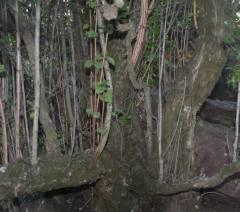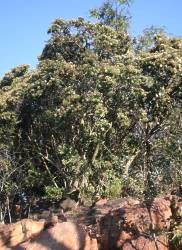Nuxia congesta
Nuxia congesta R.Br. ex Fresen.
Family: Stilbaceae
Common names: common wild elder, brittle wood (Eng.); gewone wildevlier (Afr.); umKhobesza (Xhosa); isiPhofane (Zulu)
SA Tree No: 633
Introduction
Nuxia congesta is a winter-flowering evergreen tree or shrub, with beautiful large heads of small, scented, long-lasting white or cream flowers. It is an excellent focal plant for a small garden and is easy to keep in shape.

Description
Description
Nuxia congesta is a quick-growing, evergreen tree or shrub, 2-20 m high. It has a pale grey-brown to dark brown shedding bark and hairy branchlets. The leaves are hairy, dark green, slightly leathery and variable in shape and size. They are found clustered at the ends of branchlets. Coppice leaves are soft, succulent and dark green with a serrated margin.

The flowers are small, about 5 mm long, tubular and creamy white, often tinged with mauve or purple, especially in bud. They are sweetly scented and arranged in often large congested, mushroom-shaped or flat-topped heads, at the ends of the branchlets. The fruits are small, about 3 mm long, hairy and brownish. They develop within the persistent calyx and contain fine, inconspicuous seed. Flowering time is February-November.

Conservation Status
Status
According to Raimondo et al. (2009), Nuxia congesta was of Least Concern (LC), when it was evaluated against the five IUCN (World Conservation Union) criteria and does not qualify for the categories Critically Endangered, Endangered, Vulnerable or Near Threatened.
Distribution and habitat
Distribution description
Nuxia congesta naturally occurs in dry rocky grasslands, bushveld and on the margins of forests in Limpopo, North West, Gauteng, Mpumalanga, KwaZulu-Natal and Eastern Cape. It is also found in Swaziland, Botswana, and Mozambique, extending northwards to Ethiopia.

Derivation of name and historical aspects
History
The genus Nuxia was named after M. de la Nux, a French amateur botanist on Réunion Island, and the specific name congesta refers to the crowded heads of flowers. Nuxia congesta is sometimes mistaken for Nuxia glomerulata, the leaves of which are more elliptic, leathery and glabrous. This species has a restricted distribution between Pretoria and Zeerust.
Nuxia congesta differs from Nuxia floribunda, in that the latter has longer leaf stalks, and larger, looser flowering heads. Read more about Nuxia oppositifolia.
Ecology
Ecology
The brittle wood's lovely scented flowers attract a parade of bees and butterflies to the garden, and these in turn attract insect-eating birds.

Uses
Use
This Nuxia has a hard and durable whitish yellow wood, which is used for fence posts and for fuel.
Growing Nuxia congesta
Grow
It is very easy to grow Nuxia congesta plants in a garden. Collect seeds before the fruits split. As they are very fine, mix the seed with a little fine sand and sow them under glass. Remove the glass after germination but keep the soil damp. Transplant the seedlings into pots or plastic bags when about 100-150 mm high. These trees grow best in an environment where rainfall is moderate to good and summers are warm. They do not require much water and are frost-hardy. Nuxia congesta grows reasonably fast, at a rate of about 70 cm per year, where winters are mild and there is good rainfall. Normally the plants will start flowering at about three years. Trim the branches after flowering.
References
- Coates Palgrave, M. 2002. Keith Coates Palgrave Trees of southern Africa, edn 3: 934. Struik, Cape Town.
- Germishuizen, G. & Fabian, A. 1997. Wildflowers of northern South Africa: 298. Fernwood Press, Cape Town.
- Germishuizen, G. & Meyer, N.L. (eds). 2003. Plants of southern Africa: an annotated checklist. Strelitzia 14: 333. National Botanical Institute, Pretoria.
- Germishuizen, G., Meyer, N.L., Steenkamp, Y. & Keith, M. (eds). 2006. A checklist of South African plants. Southern African Botanical Diversity Network Report No. 41: 298. SABONET, Pretoria.
- Johnson, D. & Johnson S. 2002. Gardening with indigenous trees: 72. Struik, Cape Town.
- Pooley, E. 1993. The complete field guide to the trees of Natal, Zululand and Transkei: 420-422. Natal Flora Publications Trust, Durban.
- Raimondo, D., Von Staden, L., Foden, W., Victor, J.E., Helme, N.A., Turner, R.C., Kamundi, D.A. & Manyama, P.A. (eds). 2009. Red List of South African plants 2009. Strelitzia 25: 636. South African National Biodiversity Institute, Pretoria.
- Retief, E. & Herman, P.P.J. 1997. Plants of the northern provinces of South Africa: keys and diagnostic characters. Strelitzia 6: 512. National Botanical Institute, Pretoria.
- Van Wyk, A.E. (Braam) & Van Wyk, P. 1997. Field guide to trees of southern Africa: 362. Struik, Cape Town.
Credits
M. S. Mothogoane
National Herbarium, Pretoria
February 2011
Plant Attributes:
Plant Type: Shrub, Tree
SA Distribution: Eastern Cape, Gauteng, KwaZulu-Natal, Limpopo, Mpumalanga, North West
Soil type: Sandy, Clay
Flowering season: Sporadic/All year
PH: Neutral
Flower colour: White, Cream
Aspect: Full Sun
Gardening skill: Easy
Special Features:
Horticultural zones









Rate this article
Article well written and informative
Rate this plant
Is this an interesting plant?
Login to add your Comment
Back to topNot registered yet? Click here to register.